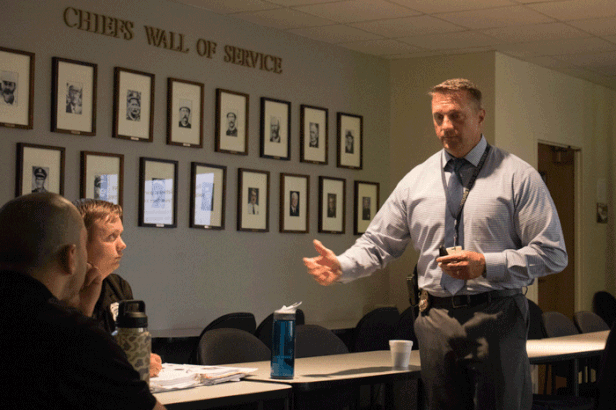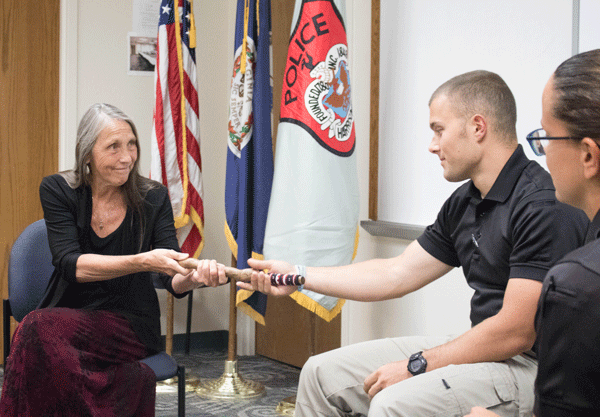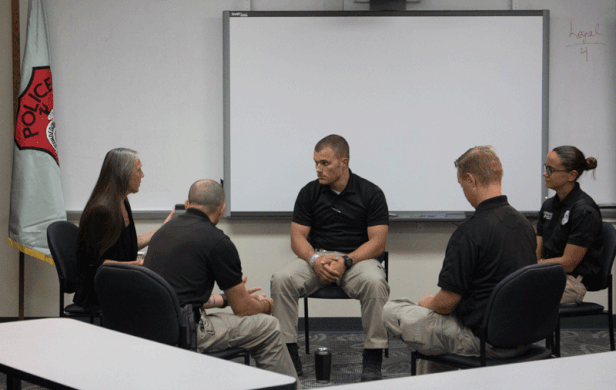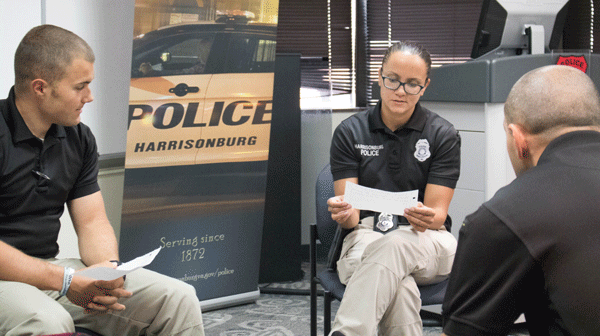By Ryan Alessi
Editor’s note: This is the second article in an occasional series on restorative justice in Harrisonburg. You can read the first installment here.
Part 1: The shot
On a bright fall afternoon, Officer Jason Hensley was on patrol, riding through Harrisonburg in an unmarked cruiser with a trainee officer at the wheel.
Hensley had rolled down the passenger side window to take in the cool breeze and casually draped his arm against the outside of the door.
The car had just passed a wooded area when Hensley heard a sharp crack. Suddenly, pain seared through his hand.
“I pulled my hand in the car, and I looked at my partner and said ‘I think somebody just shot me with a BB gun,’” Hensley said.
He flexed his hand as blood seeped from his knuckles.
“It hurt like heck.”
His partner turned the car around, and they parked by the woods. Hensley was sure it had a been a BB gun. He knew the sound well from when he was a kid.
“Whether it was intentional or not intentional, I didn’t know,” he said.
So they began to search for the source. Passing through the wooded area, they arrived in a cul-de-sac, and in the second backyard the officers came across, Hensley saw a soda can sitting on the back porch. The can was pocked with the unmistakable BB holes.
“I thought, well, it’s probably here.”
They walked around front and up to the door and knocked. A woman answered and Hensley, who was still smarting from the pain in his hand, took the lead.
“Do you have youngsters here in the house who have a BB gun?”
She seemed to be perplexed by the question. “No, I don’t think so.”
Then a boy’s voice came from the top of the stairs to the second floor. “It was me. It was me.”
Hensley could see the boy was only about 13 or 14.
Thinking about it more than two years after the fact, Hensley could laugh about it. But at the time, he was anything but amused.
“I was pissed. My hand hurt.”

Officer Jason Hensley was in an unmarked police cruiser when he got shot in the hand with a BB gun.
But a part of him knew, based on the boy’s reaction, that he might have an opportunity — or what he calls a “crossroads” situation.
“Instantly, I had ownership,” he said. “And in my world, that’s rare.”
Hensley, like other officers at the Harrisonburg Police Department, had been introduced to restorative justice several years earlier. The department had been trying to harness restorative justice process in certain situations in which the offender took responsibility and where both the victim and offender were willing to go through the often emotional, intense accountability of the Circle.
Hensley, a 12-year veteran who came to the department after switching careers, recalled being skeptical initially about whether it would result in proportionate accountability for someone who committed a crime.
“When I first heard it, I thought, ehhh, I don’t know about this, you know. In today’s world, I think the whole world’s gone soft a lot of times. So when you hear something like this, you’re thinking, oh jeez, what’s next?”
He heard in the departmental training session about what restorative justice meant and how it had been — and could be — harnessed. But he hadn’t yet referred a case to restorative justice. The conditions just hadn’t been quite right.
But on that fall afternoon, standing in the doorway facing the boy who had caused his bloody right hand, in the back of his mind, Hensley began mulling alternatives to seeing the kid hauled into juvenile court.
Still, this was serious — as in two-felonies-and-at-least-one-misdemeanor serious.
And it all came about from an unfortunate string of events. The boy, who was visiting his grandmother from Northern Virginia, and his cousin had been shooting his BB gun at a can, but they decided they wanted more of a challenge. A moving target.
One of them proposed shooting at the next car that went by. And it just happened to be Hensley’s unmarked cruiser.
“Talk about a bad set of circumstances,” Hensley said. “The car he decides to shoot is a police car. And I got hit. And I found him.”

Lt. Rod Pollard explains restorative justice to newly-hired officers at their orientation June 25.
Part 2: Embedding it in the culture
The Harrisonburg Police Department is a rarity when it comes to how restorative justice is applied. It’s one of the few, if only, departments nationally to house a restorative justice program, although other cities — such as Washington, D.C., and some communities in Colorado — run restorative justice programs through the prosecutors’ offices.
The Harrisonburg police began the program in 2015 and since then has steadily embedded it into its culture, training officers to understand restorative justice and to help them identify when specific cases might lend themselves to it.
Unlike restorative justice programs elsewhere, the department doesn’t restrict its application to certain types of crimes. Felonies. Misdemeanors. Juveniles. Adults. All could be ripe for restorative justice if conditions are right.
While certain factors are essential, such as the willingness of the victim and offender to participate, there’s no definitive checklist. It’s a case-by-case process sometimes set into motion by officers’ instincts, but it also could be initiated by the victim of a crime, a judge, juvenile court services or even a witness or another citizen.
It’s not typical policing and not likely to come up in detail in police academies. That’s one reason why the Harrisonburg Police Department devotes a half-day of its new officer orientation to introduce them to the concept and explain how restorative justice can be powerful when conditions are right.
Lt. Rod Pollard, who coordinates the department’s restorative justice program as one of his many duties, and Wonshé, a restorative justice practitioner who works with the department, spent three hours last month with the four newest members of the force. Wonshé, who learned about restorative justice from First Nations elders, goes by just the one name.
As Pollard explained to the new officers, they can recommend cases to him that might be suitable for restorative justice, either before or after making an arrest.
If Pollard also sees potential in a referred case, he passes it on to be screened by the Referral Committee, which includes a representative from Commonwealth Attorney Marsha Garst’s office. The prosecutor must sign off on any case diverted from the judicial process.
“Marsha Garst has been phenomenal,” Pollard said. “She’s been on board with this program since the beginning.”
Chief Eric English, who took over the Harrisonburg Police Department last year, became familiar with restorative justice at his last job on the force in Richmond and has encouraged the program. More than two dozen cases have been referred to restorative justice over the last two years, and about half have been successful, according to a list of cases provided to The Citizen.
Restorative justice is being strategically applied across Harrisonburg among many groups, and the police department also partners with other organizations: the Harrisonburg City Public Schools, the nonprofit FairField Center that provides mediation services, as well as JMU and EMU.
At the orientation session, Pollard and Wonshé walked the new officers through the restorative justice process, stressing how a crime — and the harm it causes — is explored through a restorative justice Circle. The Circle involves a series of meetings with the victim, also referred to as the “recipient of harm,” and the offender, or the “author of harm,” as well as the arresting officer, facilitators (usually two) and, sometimes, other community members or family members affected by the crime. The process culminates with the Circle participants agreeing on specific steps the offender must take to make amends.
“A lot of people think restorative justice is soft on crime, it’s hug-a-thug or that there is no accountability or, maybe in someone else’s words, there is no punishment,” Pollard told a group of four newly-hired officers during their orientation last month. “I’m here to tell you that going through the restorative justice process, there is a lot more accountability than I’ve ever seen in a court.”
A successful process means no court records because any charges are dropped.
If the restorative justice Circle isn’t successful for any reason — for instance, if an offender doesn’t complete all the obligations to make amends — then the case reverts back to the original charges and goes through the courts.
When Pollard surveyed the four new officers at the start of the three-hour restorative justice session, only one of the four was familiar with the concept — but only vaguely.
Pollard said when restorative justice is successful, it’s more effective than the judicial process in healing the trust between people that’s damaged when a crime is committed, whether it’s burglary, vandalism, assault or obstruction of justice such as lying about a case.
“When I started, I didn’t have the opportunity to deal with the harms that were caused to relationships in the community,” Pollard told the new officers. “It was: go out, arrest the bad guy, enforce the law and move on to the next one.”
And a crucial component of the Circle is for the arresting officer to provide a voice and represent not only how the crime affected the officer’s job and the department at large, such as diverting resources, but also how responding the call and investing time to attend the Circle affects the officer, personally.
Like a professor, Pollard works policing theory into the discussion – at one point paraphrasing a quote from Sir Robert Peel, the founder of the London Metropolitan Police Force and widely considered the father of modern policing: “The police are the public and the public are the police.”
“You are part of the community you serve,” Pollard said. “So having an opportunity in restorative justice process – in the Circle process – to have the ability to talk about how it impacted you as a police officer is extremely important in this process.”
Part 3: The hope
Officer Jason Hensley, with his hand still throbbing, collected the contact information for the boy and his parents, then had his partner drive him to MedExpress Urgent Care to patch up his bloodied knuckles, though stitches weren’t needed.
Later that evening, after his initial anger subsided, he thought about the boy’s immediate confession and the serious charges he could face: shooting at an occupied vehicle and malicious wounding — both felonies — and shooting a BB gun inside the city limits, a misdemeanor.
“I thought, This kid doesn’t need to be prosecuted. It’s not going to do him any good at all to drag him into the juvenile/domestic side of the court,” Hensley said. “There probably was not going to be a positive outcome if we went that way.”
The boy’s father drove to Harrisonburg the next day and hired an attorney, who called Hensley to set up a meeting.
“The good thing was, this was a day later. I cooled down. I was no longer pissed. And so we sat down and talked,” Hensley said.
They decided restorative justice was the right path.
Hensley made the formal referral, it got approved, and then the tough work began in the Circle.
Hensley was in an unusual position because he was not only serving as the police officer but was also the recipient of harm. So instead of attending the Circle in his uniform, Hensley wore street clothes.
At the first meeting, Hensley and the boy sat in a circle along with two facilitators. And not long after Hensley began talking about how he was affected by the boy’s reckless BB gun pot-shot, the boy got upset.
“I asked him ‘why are you crying?’” Hensley recalled. “He said, ‘Cause I hurt you’.”
“The kid was awesome. Very receptive. Smart young man,” Hensley said. “But I wasn’t going to make it easy on him.”
The boy was at a crossroads. And Hensley said one reason he was always attracted to police work was because it was an opportunity to help people at some of their darkest moments to choose a new, brighter path.
“The hope is that they come out to be a decent person, be a good citizen and understand what they did was wrong,” he said.
Hensley began to think of different ways the boy could not only make amends for his actions but learn and grow as well.

Wonshé, a restorative justice practitioner who works with the Harrisonburg Police Department, passes a talking stick to Noah Emswiler, one of the new officers, during their orientation to the restorative justice Circle.
Part 4: Understanding the harm
For Lt. Rod Pollard, it was hard to understand the potential transformative effects of restorative justice until he watched it happen in his first Circle.
Pollard is also special operations commander and oversees key units, such as the SWAT team and criminal investigations division. Soon after taking over coordinating the restorative justice program upon the retirement of the lieutenant who started it, Pollard joined a Circle to represent the police department.
“The first Circle process that I sat through was absolutely amazing,” he told the four newly-hired officers during their orientation.
It was a case of four JMU students who broke into a local business to seek props and decorations for a golf-themed party.
“The destroyed a $1,000 sign, trying to rip it out of the ground,” Pollard said. “They stole about $2,000 worth of merchandise — golf memorabilia, flags.”
The owners, though, lived on site and were awakened by the noise. They called the police, who interrupted the crime and caught two of the men. The other two ran away.
The arresting officer, who had been through restorative justice training, approached the owners to ask whether they would be amenable to going through restorative justice with the two men caught at the scene.
“Initially the two owners were upset … they had been victimized, they wanted justice for these men,” Pollard said.
But they gave it a chance and, in the process, imparted on the men that not only did they cause thousands of dollars in damage and shake their sense of security, but explained that other nearby businesses took steps to bolster their security, Pollard said.
The owners proposed in Circle a list of amends: repairing the sign, writing reflection papers, doing 200 hours of community service and providing the names of the other two who got away.
“The boys were just in tears and said ‘Absolutely, whatever you ask of us, we’re going to do,’” Pollard said.
Ultimately, Pollard said what he witnessed in the Circle was transformative for him.
“I was blown away. I had never seen anything in my 25 years of law enforcement that was even close to what happened at that table,” he told the new officers. “The tears shed by those offenders. The remorse. The sense of obligation … to do whatever it takes to repair those harms.”
And to see the victims evolve from expressing anger to, at the end, hugging and exchanging phone numbers with all four men who broke into their business was equally powerful, he said. In the end, the four men also made a presentation to Harrisonburg Police Department officers in a restorative justice training session.
The anecdote, which Pollard relayed to the new officers in their orientation, was a prelude to a bigger point he and Wonshé made about how important police officers’ roles are in the Circles.
It helps strengthen that trust between officers and the people they’re sworn to protect, Pollard said.
“It’s critical, actually,” Wonshé said. “And it’s very powerful — very powerful to see that care and compassion and that side of policing that most people don’t get to see.”
“Restorative justice gives you a voice in this process,” Pollard added. “It gives the victim a voice. It gives the offender a voice … and it’s very important you have a voice to talk about how it impacted you as an officer, you as a person, us as a department.”
Pollard then mentioned to the new officers the case that most powerfully wrapped all three into one: the instance when a boy shot an officer with a BB gun.
That scenario — Officer Hensley’s case — would serve as the example the new officers used for their first Circle experience, which Wonshé led. She assigned each of the four trainees a different role: Officer Hensley, Hensley’s partner who was driving the car, the boy’s father and the boy.
Wonshé explained to the four trainee officers that a pair of themes always come up when a recipient of harm first confronts that person no matter what the crime is.
“They all pretty much want to know the same thing,” she said. “No. 1 – why me? Why did you pick me to burglarize or why did you shoot at my vehicle? And No. 2, what were you thinking? What was in your head? What was your thought process? What in the world possessed you to do this thing? Those are the things people really want to hear.”
Wonshé then asked each trainee to talk about the effects of the boy’s shot. The pain in Hensley’s hand. The embarrassment and anger it caused the boy’s father. The concern from Hensley’s partner, as well as the time diverted from other duties in order for the two of them to respond to the shot and for Hensley to get medical treatment.
“You get the sense of how once you start talking about it, it’s like dropping a pebble in the water,” said Wonshé, who served as one of the facilitators in Hensley’s case. “Ripples go out. It might be just a tiny ripple over here, but it’s still touching people.”
And the specific effects of those ripples — the ways in which harm touched people and damaged trust — then serve as “guideposts” for Circle participants to agree on what the author of harm must do to make amends, Wonshé said.
“It’s not prescriptive,” she said. “It’s not like in a courtroom where it’s a Class 3 misdemeanor and here’s the typical punishment that goes with it … It’s very specific to all the information that’s been brought out.”

Wonshé leads the new police officers through an example of a restorative justice Circle.
Part 5: The amends
As the recipient of harm (and a pellet to the hand), Officer Hensley suggested what he wanted the boy to do to not only make amends but to show that he had changed.
“So I thought back to when I was his age and what did I not like to do then that probably helped me? And one was writing,” Hensley said. “I liked to read, but I never liked to write.”
Hensley asked the boy to hand write, not type, a 1,000 word essay about what it takes to be a good citizen.
The Circle also agreed the boy and his father should take a firearms safety course and that the boy should complete community service, which would be spent helping the Harrisonburg Police Department.
Hensley arranged for him to wash and detail more than a dozen police cruisers, with Hensley’s help and supervision, then took the boy to lunch and on a ride-along that afternoon. They made a few traffic stops and talked with community members.
“It was a good day,” Hensley said.
During the new officer orientation session, Wonshé asked the trainees while playing their roles in the Circle to come up with suggestions on how the boy who shot Hensley could make amends. Each of the new officers chimed in, hitting every obligation the actual Circle had prescribed for the boy, including the ride-along.
“I thought that was a really perfect thing to do because here he shot into a police officer’s vehicle, and what an experience to be in a vehicle and be driving around and feel that vulnerability,” Wonshé told the trainees. “You guys are really connected to this concept.”
Christine Hostetter, one of the new officers, was the one assigned to play the role of the boy, which she said was uncomfortable even just pretending.
“It was pretty difficult,” she said. “But it does open your eyes to how your actions affect more than just those who were directly touched.”
Hostetter, who worked for seven years as a firefighter, was one of the trainees who said at the beginning of the orientation session that she didn’t really know what restorative justice was.
But by the end, she said she thought it had the potential to be even more of a long-term fix when the conditions are right.
“I feel like restorative justice is really about healing all parties involved on a deeper level that will continue the rest of their lives rather than just throwing the book at them,” she said.

Christine Hostetter, one of the new officers, learns she will be playing the role of the boy who shot Officer Jason Hensley with a BB gun.
And she and the other three trainees will have their chance to test that. During the orientation session, Pollard gave them an assignment: to refer at least one case to restorative justice during their first 30 days. And, he said, if they couldn’t identify one, they must write him an essay explaining why they couldn’t refer one.
Hostetter said she didn’t think finding an opportunity to suggest restorative justice would be difficult but expected the biggest challenge would be for a victim of a crime to agree to it.
As for Hensley, he said his first and only referral so far to restorative justice was an all-around success.
“He wrote a really good essay,” he said of the boy. “For as young as he is, he did a fabulous job with references and footnotes. Yeah, for the first one, it was a grand slam.
“Well,” he added, “I feel like it was.”
Journalism is changing, and that’s why The Citizen is here. We’re independent. We’re local. We pay our contributors, and the money you give goes directly to the reporting. No overhead. No printing costs. Just facts, stories and context. Thanks for your support.














